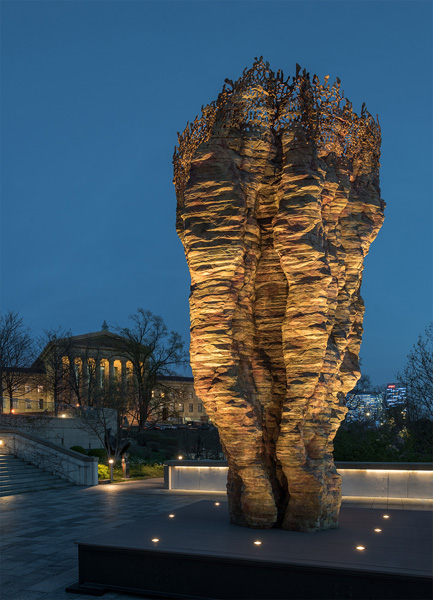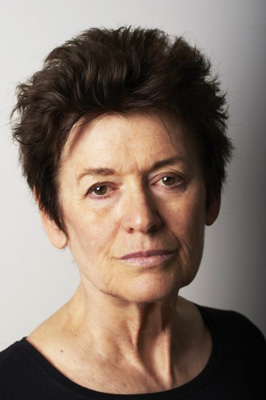Evoking the Power of Nature in Bronze
 Bronze Bowl with Lace, 2013–14 (cast 2017–18), by Ursula
Bronze Bowl with Lace, 2013–14 (cast 2017–18), by Ursula
von Rydingsvard (American, born Germany 1942).
Courtesy of the artist and Galerie Lelong & Co.
© Ursula von Rydingsvard
In the darkness of Philadelphia’s evening and early morning hours, an amber light illuminates from within the bronze sculpture Bronze Bowl with Lace (2013–14, cast 2017–18) by Ursula von Rydingsvard. With the Philadelphia Museum of Art sitting in the distance, this monumental sculpture by one of today's most influential sculptors is equally enthralling to view by daylight.
The artist's approach to scale, with this particular piece standing almost twenty feet tall is captivating, along with her complex use of materials and technique.
On view through April 2020, two of von Rydingsvard's sculptures are part of the museum's outdoor exhibition that makes up their Anne d'Harnoncourt Sculpture Garden, named in honor of the museum's late director. The other piece, Elegantka II, is a urethane resin cast of another full-scale cedar model.
This gallery without walls is an ideal destination to take in works on a spring-like day within an intentional landscape that serves as a backdrop for many distinguished artists, in addition to von Rydingsvard, including Claes Oldenburg, Gordon Gund, Sol LeWitt, Scott Burton, Thomas Schütte and Ellsworth Kelly. The full exhibition experience is located within five different sections of the terraced grounds.
 Image courtesy of Philadelphia Museum of
Image courtesy of Philadelphia Museum of Art, 2018. Photo by Tim Tiebout.
Coinciding for a portion of time with von Rydingsvard's solo exhibition Ursula von Rydingsvard: The Contour of Feeling that was on view at the Fabric Workshop and Museum last year, when Bronze Bowl with Lace was delivered to the Anne d'Harnoncourt Sculpture Garden, it was installed in three parts by the use of a crane and team of helpers that stacked one section upon the other.
At the very top of the piece, a perforated portion of the work is lacelike in appearance.
"They are in all different fragmented sections," says Samuel Brown, a gallery guide at the Fabric Workshop and Museum located on Arch Street in Philadelphia, of von Rydingsvard's pieces. "She has a team of people who help her out who are really good at building them and taking them apart."
At the Fabric Workshop and Museum, von Rydingsvard's pieces were displayed in the confines of a gallery space which is an environment that is in stark contrast to taking her work in outdoors, given the organic nature of her work that appears as though it was born out of a natural environment.
"I think it's almost kind of surreal seeing them inside since they are so organic looking," Brown says. "The reason it's interesting to see them in an indoor space is because it looks like they belong in a natural environment."
 Image courtesy of Philadelphia Museum
Image courtesy of Philadelphia Museum of Art, 2018. Photo by Tim Tiebout.
Bronze Bowl with Lace was cast from a full-scale cedar model, with cedar wood being von Rydingsvard's signature medium. Most of her work involves a process of cutting, shaping and then assembling them using thousands of cedar blocks.
"They are made to withstand the elements," Brown says of von Rydingsvard's bronze pieces.
Other bronze works in the one-acre garden that are integrated into the landscape include Giant Three-Way Plug (Cube Tap) by Claus Oldenburg, made of bronze and COR-TEN steel; Bell by Toshiko Takaezu made of bronze and white oak; Flukes by Gordon Gund, made of bronze with a marble base; and Gift by William G. Tucker, made of bronze.
Born in Deensen, Germany, von Rydingsvard has lived and worked in New York since the 1970s.
Her work has been exhibited internationally and is represented in the collections of major museums including the Metropolitan Museum of Art; the Museum of Fine Arts, Boston; the Museum of Modern Art; the National Gallery of Art; the San Francisco Museum of Modern Art; the Walker Art Center; and the Storm King Art Center.
 Portrait of Ursula von Rydingsvard.
Portrait of Ursula von Rydingsvard. © Ursula von Rydingsvard, courtesy
Galerie Lelong & Co.Photo by Zonder
Titel and Zack Garlitos.
Von Rydingsvard's commissioned sculpture URODA, 2015 was her first sculpture made primarily of copper, and later became part of the permanent collection of the Princeton University Art Museum.
The finished piece, made of more than 3,000 hand-hammered copper pieces, also involved bronze and steel.
Regardless of medium, von Rydingsvard's abstract forms seem to beg some to want to interpret them.
"I think one of the most interesting things about her work is you look at these forms and your brain is so ready to jump to this idea of what it's representing," Brown says.
"It is interesting how these abstract forms can portray some kind of emotion -- it's almost like looking up at the clouds and trying to see if any of them take any specific shape," says Brown. "There is something contemplative when looking at them."
Resources:
Also in this Issue:
- Garage Sale Bronze Statue Featured on Antiques Roadshow Sells at Sotheby’s for $2.1 Million
- Exploring the Deep and Widespread Roots Of Folk Art in NYC
- The Iconic Galle Chandelier Gets a Closeup at Getty
- Evoking the Power of Nature in Bronze
- MOMA Announces 2020 Donald Judd Retrospective
